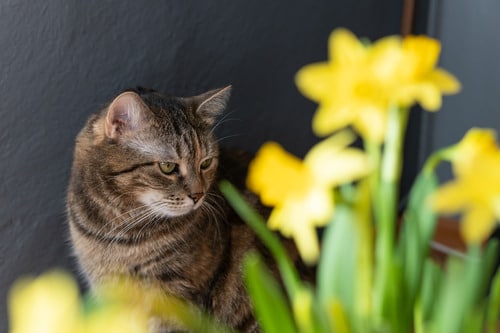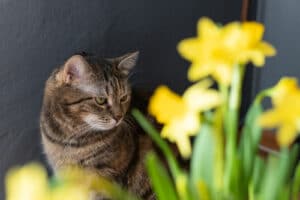Cats are naturally curious, and their love for exploring often brings them nose-to-leaf with plants both indoors and outdoors. While greenery adds beauty to our homes and landscapes, not all plants are safe for pets. Many common flowers, shrubs, and household plants are poisonous plants for cats and can lead to serious health problems if ingested. As a pet parent, knowing which plants pose risks helps you create a safer environment for your feline. If you’re ever concerned that your cat may have been exposed to a harmful plant, contact Arrowhead Animal Hospital in Westminster at (303) 469-1616 or book an appointment online.
Why You Should Know About Poisonous Plants for Cats
Cats often chew on plants out of curiosity, boredom, or even instinct. Unfortunately, certain plants contain natural toxins that can damage the liver, kidneys, or nervous system. Some plants cause mild irritation, while others can lead to life-threatening complications. Understanding which plants are poisonous plants for cats allows you to make safe choices when decorating your home, choosing floral arrangements, or planning your garden. By avoiding or removing these plants, you reduce the risk of accidental ingestion and help your cat live a healthier, safer life.
1. Lilies
Lilies are among the most dangerous poisonous plants for cats. Every part of the plant, including leaves, petals, stems, and even pollen can be harmful if a cat ingests or licks them. Even a small exposure, such as brushing against pollen and grooming it off their fur, may lead to severe health consequences.
Why Lilies Are So Dangerous
Lilies contain compounds that can cause sudden kidney problems in cats. This makes them especially concerning since they are often found in bouquets, Easter decorations, or as ornamental flowers in gardens. Cat parents should avoid bringing lilies into their home altogether.
2. Azaleas and Rhododendrons
Azaleas and rhododendrons are vibrant flowering shrubs that are common in gardens across Colorado. Unfortunately, they are also poisonous plants for cats. These plants contain substances called grayanotoxins that interfere with normal muscle and nerve function. If your cat chews on azalea or rhododendron leaves, it could lead to serious health concerns. Because these shrubs are so widespread, pet owners should remain especially vigilant during spring and summer when they bloom.
3. Tulips
Tulips bring bright color to gardens and floral arrangements, but they are not safe for cats. The toxic compounds in tulips are concentrated in the bulbs, though the leaves and flowers can also be harmful.
The Hidden Risk with Bulbs
Many cats dig in garden beds or potted plants, increasing their chance of contact with tulip bulbs. Because the bulb holds the highest toxin concentration, planting tulips in areas accessible to cats is risky. Consider alternatives if you want safe spring flowers in your home.
4. Oleander
Oleander is a hardy ornamental shrub with clusters of delicate flowers. While beautiful, it is one of the most toxic plants for pets. Oleander contains cardiac glycosides, which affect the heart and can be fatal if consumed. This plant thrives in warmer climates and can sometimes be found in Colorado landscapes. Because every part of the plant is poisonous, oleander should never be planted in a yard where cats roam.
5. Sago Palm
Sago palms are popular indoor plants, but they are highly dangerous to cats. These plants contain a toxin called cycasin, which is concentrated in the seeds but is present throughout the plant. Cats that ingest any part of a sago palm are at risk of severe organ damage. Because these plants are often sold in garden centers and nurseries as decorative palms, pet owners should be cautious when shopping for indoor greenery.
6. Daffodils
Daffodils brighten spring gardens, but they are another example of poisonous plants for cats. The bulbs are especially toxic, containing alkaloids that affect the digestive system and nervous system.
Why Outdoor Cats Are at Higher Risk
Cats that spend time outdoors in the spring may wander into garden beds where daffodils are planted. Even nibbling on fallen petals or leaves can expose them to harmful substances. For safer gardening, choose cat-friendly flowers instead of daffodils.
7. Dieffenbachia (Dumb Cane)
Dieffenbachia, also called Dumb Cane, is a common houseplant with large, variegated leaves. While it makes an attractive indoor plant, it is toxic to cats. The plant contains insoluble calcium oxalate crystals. When chewed, these crystals can irritate a cat’s mouth, tongue, and throat. While the effects may be less severe than other poisonous plants for cats, Dumb Cane should still be avoided in households with curious pets.
8. Autumn Crocus
The autumn crocus, which blooms in the fall, is different from the common spring crocus. This variety contains colchicine, a highly toxic substance that can cause severe health complications in cats. Because autumn crocus plants resemble harmless spring flowers, many pet owners are unaware of the danger. If you enjoy bulb flowers in your garden, always verify which variety you are planting.
Safer Plant Alternatives for Cat Owners
While there are many poisonous plants for cats, you don’t have to give up greenery in your home or yard. Several cat-friendly options are safe to grow indoors and outdoors.
Cat-Safe Choices to Consider
- Spider Plant – A hardy, non-toxic houseplant that cats often enjoy.
- Areca Palm – A safe decorative palm for indoor use.
- Boston Fern – Adds lush greenery without posing a danger.
- Cat Grass – Easy to grow and provides a safe nibbling option for your pet.
Choosing safe alternatives allows you to enjoy plants while protecting your cat from unnecessary risks.
Creating a Safer Environment for Your Cat
Understanding which plants are poisonous plants for cats helps you make safer choices for your home and garden. By removing harmful plants and replacing them with cat-friendly alternatives, you create an environment where your cat can explore without unnecessary risks. If you suspect your cat has come into contact with any of the plants listed above, call Arrowhead Animal Hospital in Westminster at (303) 469-1616 right away. Our veterinary team is equipped to provide guidance and care to help protect your pet’s health.





